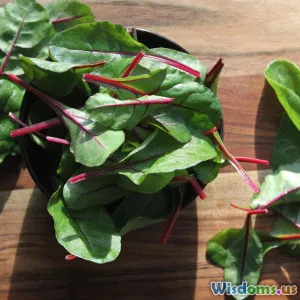
The Top Five Leafy Greens Ranked by Nutrient Density
16 min read Discover the five most nutrient-dense leafy greens for a healthier diet, ranked with nutrition facts, cooking tips, and health benefits. (0 Reviews)
The Top Five Leafy Greens Ranked by Nutrient Density
There’s a reason leafy greens are often hailed as the backbone of a healthy diet. Rich in vitamins, minerals, and disease-fighting phytochemicals, these plants make every bite pack a punch. Yet, not all leafy greens are created equal. If you’re wondering which to choose to squeeze the most nutrition from each salad, smoothie, or side dish, dive in as we explore the top five leafy greens ranked by nutrient density—backed by the science of the Nutrient Density Index and real-world examples of how to use them.
1. Kale: The Reigning Nutrient Density Champion

Kale has earned its spot as the poster child of modern nutrition—and it wears the crown for good reason. According to the Aggregate Nutrient Density Index (ANDI) created by Dr. Joel Fuhrman, kale secures a perfect score of 1,000—the highest possible. This index rates foods based on micronutrients per calorie.
Nutrient Profile and Highlights:
- Vitamin K: One cup of raw kale provides nearly 7 times the recommended daily value (DV), crucial for blood clotting and bone health.
- Vitamin A: In the form of beta-carotene, kale delivers more than 200% of the DV per cup.
- Vitamin C: With 80 mg per cup, it provides almost 90% of the DV—beating even oranges cup for cup.
- Antioxidants: Lutein, zeaxanthin, and quercetin protect cells from oxidative damage and support eye health.
- Minerals: Contains calcium, potassium, iron, and magnesium.
Versatility in the Kitchen:
- Raw in salads or smoothies (massage with olive oil to soften).
- Baked as kale chips—for a crave-worthy, nutrient-packed snack.
- Sauteed with garlic, lemon, and chili flakes as a quick side.
Pro Tip: Buying locally sourced, organic kale can reduce pesticide exposure, since leafy greens tend to absorb more chemicals from soil and water.
2. Spinach: The Age-Old Nutritional Powerhouse

A favorite of cartoon icon Popeye and nutritionists alike, spinach is often synonymous with strength and wellness. With an ANDI score of 739, it more than earns its place on the list.
Key Nutritional Benefits:
- Iron: One cup of cooked spinach contains about 6 mg, more than a third of the DV, helping support oxygen transport in the blood.
- Folate (Vitamin B9): Critical for DNA synthesis and crucial during pregnancy; one cup raw covers nearly 15% of the DV.
- Vitamin K: Just like kale, spinach is loaded, providing over half the daily requirement in a mere handful.
- Phytonutrients: Flavonoids and carotenoids protect against chronic diseases.
Preparation Ideas:
- Raw in salads or sandwiches.
- Wilted into sauces, pasta, or omelets.
- Blended into smoothies for a mild flavor and vivid color boost.
Important Note: While spinach offers non-heme iron, pairing it with vitamin C-rich foods (like lemon juice or strawberries) significantly boosts iron absorption. Be cautious if you have a history of kidney stones, as spinach is high in oxalates that can promote stone formation for at-risk individuals.
3. Swiss Chard: The Colorful Cholesterol Challenger

Swiss chard doesn’t just look dazzling with its rainbow-hued stems—it’s also a nutritional powerhouse. An ANDI score of 670 puts it in the top tier, but what makes chard stand out is its unique phytochemical content and versatility.
Nutritional Standouts:
- Vitamin K: Cooked chard provides over three times the DV per cup.
- Vitamin A: Both raw and cooked chard offer over 40% of the DV per serving in pro-vitamin A carotenoids.
- Magnesium, Potassium, and Iron: These minerals can support muscle, nerve, and red blood cell health.
- Phytonutrients: Betalains—pigments also found in beets—possess antioxidant and anti-inflammatory properties.
- Cholesterol Management: Chard contains syringic acid, a compound linked to blood sugar regulation.
Culinary Uses:
- Sauteed as a side or samosa filling.
- Added to grain bowls and stir-fries.
- Blanched and wrapped around fillings for nutrient-dense wraps.
Expert Tip: Both the stems and leaves of Swiss chard are edible! Cook stems longer or chop finely for even tenderness.
4. Collard Greens: The Southern Staple with a Nutrient Punch

Collard greens are a culinary classic in Southern American food, but they shine globally for their robust flavor and dense nutrient content.
What Sets Them Apart?
- Calcium: One cooked cup offers over a quarter of your daily needs—outstanding among leafy greens.
- Vitamins K, A and C: Each cup delivers huge proportions of these immune and bone-supporting vitamins.
- Detoxifying Compounds: Like all crucifers (family includes kale, broccoli, Brussels sprouts), collards provide sulforaphane, shown in lab studies to stimulate the body’s detox mechanisms and may reduce cancer risk.
Preparation Avenues:
- Traditional: Braised with a touch of smoked meat or a vegan version with smoked paprika.
- Modern: As gluten-free sandwich wraps.
- Chopped into soups or curries for added bulk.
Cooking Smarter: Collard greens’ bitter taste mellows with slow cooking. Boiling and then quickly submerging in cold water helps preserve their vivid color and nutrients.
5. Romaine Lettuce: The Salad Mainstay with Hidden Virtues

Romaine lettuce doesn’t always get the spotlight in the world of “supergreens,” but an ANDI score of 510 ranks it head and shoulders above iceberg and many other salad greens. It’s especially rich in nutrition for how few calories it offers.
Nutritional Breakdown:
- Vitamins A and K: One cup provides over 80% and 60% DV respectively.
- Folate: Half of your daily need is in a head of romaine—important for heart and prenatal health.
- Manganese and Fiber: Supports metabolism and digestive health.
- Hydration: Over 90% water, making it great for hydrating meals and weight management.
Everyday Uses:
- Crisp base for robust salads.
- Wraps and taco shells as a high-fiber, low-carb swap.
- Sliced and added to sandwiches or burgers for a refreshing crunch.
Pro Tip: Pregnant women and those with immune compromise should wash romaine extra thoroughly and be aware of recall warnings, as leafy greens can carry foodborne pathogens if not handled and stored carefully.
Factors Affecting Nutrient Density

Nutrient density isn’t static—it can change from garden to grocery store to plate. If you want every bite of greens to deliver the most value, here’s what affects nutrient content:
1. Growing Conditions
- Soil Quality: Rich, organic soils tend to yield greens with higher mineral content.
- Sunlight and Environmental Factors: Greens grown in full sunlight have higher concentrations of some vitamins and phytonutrients.
2. Harvest and Storage
- Freshness: Nutrient levels, especially vitamin C and B vitamins, often decline after harvesting.
- Storage Tips: Wrap greens in a paper towel in the fridge's crisper drawer. Avoid plastic if possible to reduce moisture trapping and spoilage.
3. Preparation and Cooking
- Raw vs. Cooked: Some nutrients (like vitamin C) are heat-sensitive and degrade with cooking, while others (such as carotenoids and minerals) are more available in cooked greens.
- Pairing with Fats: Sautéing greens with healthy fats (such as olive oil) enhances absorption of fat-soluble vitamins A, D, E, and K.
Smart Ways to Add More Leafy Greens to Your Diet

If you find salads monotonous or have family members who object to visible greens, creativity is your ally. Here are practical strategies to steadily boost your intake:
- Smoothies: Blend a handful of spinach, kale, or chard with a banana and frozen berries for breakfast. The fruit masks the taste and maximizes nutrient absorption.
- Egg Dishes: Stir chopped greens into omelets, quiches, or scrambled eggs.
- Grain Bowls: Mix wilted kale, chard, or collards into brown rice, quinoa, or barley bowls. Top with roasted chickpeas and a tahini drizzle.
- Soups and Stews: Stir chopped greens into simmering soups in the last few minutes of cooking.
- Healthy Chips: Bake kale or collard leaves brushed with olive oil for a nutrient-rich snack.
- Wraps and Sandwiches: Use leaves for wraps or add hefty handfuls to sandwiches, paninis, and even tacos.
Consistency Over Perfection: Rather than aiming for one big salad a day, focus on adding greens to meals you already enjoy. Incremental increases are more sustainable than radical overnight changes.
Maximizing Absorption: Small Tweaks, Big Results

Eating nutrient-rich greens is only useful if your body can absorb those nutrients efficiently. Optimize your greens for absorption with the following approaches:
- Combine with Healthy Fats: Some vitamins are fat-soluble, so pair greens with avocado, nuts, seeds, or a splash of olive oil.
- Pair with Acidic Foods: Adding lemon juice or vinegar to salads or steamed greens helps uptake iron.
- Cook Smartly: Lightly steaming or sautéing can enhance bioavailability for certain antioxidants and reduce goitrogen levels (substances in raw cruciferous greens that impair thyroid function in sensitive individuals).
- Rotate Your Greens: Vary types to minimize the risk of consuming excessive natural plant compounds like oxalates or goitrogens.
- Mind the Supplements: If you’re on anticoagulants (blood thinners), consult your doctor—sudden changes in vitamin K intake can impact medication efficacy.
When Quantity Trumps Quality: Iceberg’s Place (And Why It Ranks Low)

With its signature crunch, iceberg lettuce often finds its way into salads and burgers. However, from a nutrient-density perspective, it ranks significantly below our top five, with an ANDI score under 130. While it is very low in calories and hydrating, it offers far less in vitamins, minerals, and antioxidants.
Best Use:
- Excellent as a hydrating, low-calorie base for heavier toppings or to add crunch.
- For additional nutrition, blend a modest amount with darker greens, or rotate it out in favor of romaine or spinach.
Reality Check: Iceberg lettuce isn’t harmful—but aiming for more robust greens means you’re getting more nutrition from every crisp, leafy bite.
The Bottom Line: Choosing Your Everyday Supergreens

The evidence is clear: accessible, versatile, and vibrant, leafy greens deliver immense nutritional value across cuisines and diets. While kale tops the list for nutrient density, spinach, Swiss chard, collard greens, and romaine lettuce all make compelling cases to earn a regular spot on your plate. The best news? Nutrient density means you can eat a lot for very few calories, making them ideal for weight management, disease prevention, and supporting overall wellbeing.
Start by choosing one or two varieties to add to your weekly meals. Whether you sauté, blend, bake or simply toss them raw, these lush greens will return the favor by energizing your body cell by cell.
Rate the Post
User Reviews
Popular Posts















